Adaptive-scanning optical microscope
an optical microscope and adaptive scanning technology, applied in the field of optical microscopy, can solve the problems of significant design and implementation challenges in system configuration, and achieve the effect of improving performan
- Summary
- Abstract
- Description
- Claims
- Application Information
AI Technical Summary
Benefits of technology
Problems solved by technology
Method used
Image
Examples
Embodiment Construction
[0045] Referring now to the drawings, in which like reference numerals are used to refer to the same or similar elements, FIG. 1 shows the adaptive scanning optical microscope or ASOM 10 which operates by taking a sequence of small spatially displaced images in succession from an object 12, and then assembling a large composite image (mosaic) or several disjoint or possibly overlapping images of the scene.
[0046] While the general concept of expanding the field of view while preserving resolving power through mosaic construction is known and has been applied to biological imaging (see J. Zemek, C. Monks, and B. Freiberg, “Discovery through automation,” Biophotonics International 10, 54-57 (2003)) as well as to industrial imaging (see C. Guestrin, F. Cozman, and S. Godoy, “Industrial applications of image mosaicing and stabilization,” in Proceedings of IEEE International Conference on Knowledge-Based Intelligent Electronic Systems—Institute of Electrical and Electronics Engineers, Ne...
PUM
 Login to View More
Login to View More Abstract
Description
Claims
Application Information
 Login to View More
Login to View More - R&D
- Intellectual Property
- Life Sciences
- Materials
- Tech Scout
- Unparalleled Data Quality
- Higher Quality Content
- 60% Fewer Hallucinations
Browse by: Latest US Patents, China's latest patents, Technical Efficacy Thesaurus, Application Domain, Technology Topic, Popular Technical Reports.
© 2025 PatSnap. All rights reserved.Legal|Privacy policy|Modern Slavery Act Transparency Statement|Sitemap|About US| Contact US: help@patsnap.com



